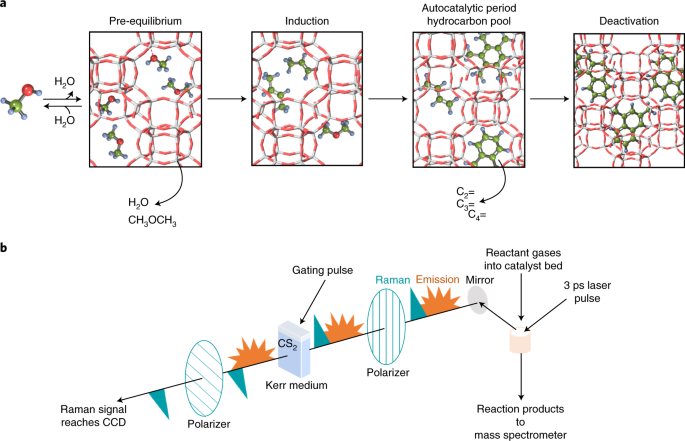
Authors (12): I. Lezcano-González, E. Campbell, A. E. J. Hoffman, M. Bocus, I. V. Sazanovich, M. Towrie, M. Agote-Arán, E. K. Gibson, A. G. Greenaway, K. De Wispelaere, V. Van Speybroeck, A. M. Beale
Themes: Featured, Design DOI: 10.1038/s41563-020-0800-y
Citations: 87
Pub type: article-journal
Pub year: 2020
Publisher: Springer Science and Business Media LLC
Issue: 10
License: {"URL"=>"http://www.springer.com/tdm", "start"=>{"date-parts"=>[[2020, 9, 14]], "date-time"=>"2020-09-14T00:00:00Z", "timestamp"=>1600041600000}, "delay-in-days"=>0, "content-version"=>"tdm"} {"URL"=>"http://www.springer.com/tdm", "start"=>{"date-parts"=>[[2020, 9, 14]], "date-time"=>"2020-09-14T00:00:00Z", "timestamp"=>1600041600000}, "delay-in-days"=>0, "content-version"=>"vor"}
Publication date(s): 2020/10/14 (online)
Pages: 1081-1087
Volume: 19 Issue: 10
Journal: Nature Materials
URL: http://dx.doi.org/10.1038/s41563-020-0800-yThe methanol-to-hydrocarbons reaction refers collectively to a series of important industrial catalytic processes to produce either olefins or gasoline. Mechanistically, methanol conversion proceeds through a ‘pool’ of hydrocarbon species. For the methanol-to-olefins process, these species can be delineated broadly into ‘desired’ lighter olefins and ‘undesired’ heavier fractions that cause deactivation in a matter of hours. The crux in further catalyst optimization is the ability to follow the formation of carbonaceous species during operation. Here, we report the combined results of an operando Kerr-gated Raman spectroscopic study with state-of-the-art operando molecular simulations, which allowed us to follow the formation of hydrocarbon species at various stages of methanol conversion. Polyenes are identified as crucial intermediates towards formation of polycyclic aromatic hydrocarbons, with their fate determined largely by the zeolite topology. Notably, we provide the missing link between active and deactivating species, which allows us to propose potential design rules for future-generation catalysts. The methanol-to-hydrocarbons reaction on zeolites produces olefins from many sources, but catalyst stability is a major challenge. Here, by combining operando measurements and simulations, the formation and identification of deactivating carbonaceous species throughout the reaction are achieved.
| Name | Description | Publised |
|---|---|---|
| supporting-info | supporting-info... | 2020 |
| 41563_2020_800_MOESM1_ESM.pdf | Supl. data for Insight into the effects of confined hydrocarbon species ... | 2020 |
| 41563_2020_800_MOESM2_ESM.xlsx | Supl. data for Insight into the effects of confined hydrocarbon species ... | 2020 |
| 41563_2020_800_MOESM3_ESM.xlsx | Supl. data for Insight into the effects of confined hydrocarbon species ... | 2020 |
| 41563_2020_800_MOESM4_ESM.xlsx | Supl. data for Insight into the effects of confined hydrocarbon species ... | 2020 |
| 41563_2020_800_MOESM5_ESM.xlsx | Supl. data for Insight into the effects of confined hydrocarbon species ... | 2020 |
| 41563_2020_800_MOESM6_ESM.xlsx | Supl. data for Insight into the effects of confined hydrocarbon species ... | 2020 |
| 41563_2020_800_MOESM7_ESM.xlsx | Supl. data for Insight into the effects of confined hydrocarbon species ... | 2020 |
| 41563_2020_800_MOESM8_ESM.xlsx | Supl. data for Insight into the effects of confined hydrocarbon species ... | 2020 |
| 41563_2020_800_MOESM9_ESM.xlsx | Supl. data for Insight into the effects of confined hydrocarbon species ... | 2020 |
| 41563_2020_800_MOESM10_ESM.xlsx | Supl. data for Insight into the effects of confined hydrocarbon species ... | 2020 |
| 41563_2020_800_MOESM11_ESM.xlsx | Supl. data for Insight into the effects of confined hydrocarbon species ... | 2020 |
| 41563_2020_800_MOESM12_ESM.xlsx | Supl. data for Insight into the effects of confined hydrocarbon species ... | 2020 |
<< Previous Back Next >>